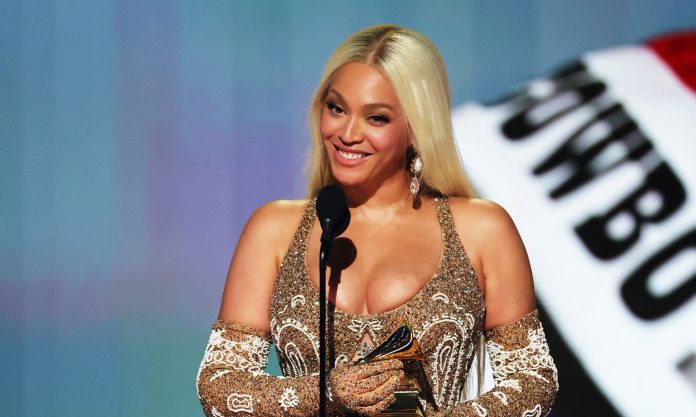When you think of country music, what do you think of? The answer depends on who you ask. Some might picture a Blake Shelton-type figure—white, clad in plaid and bootcut jeans, cowboy boots tapping to the rhythm of a song about his love for his country/wife/family. He leans against a Ford truck, an American flag waving behind him, a Bud Light in hand with the logo conveniently facing the camera.
But how does Beyoncé fit into country music? To understand her place in the genre, we have to look beyond John Deere trucks and cowboy hats to its true origins. Black musicians planted the seeds long before your Chris Stapletons and Luke Bryans were born.
Our story begins with a humble instrument, the banjo: country music’s symbol, heart, and soul. The stringed instrument’s history is finely tuned to West and Central African traditions. Enslaved Africans created the earliest form of the banjo by using gourds grown on the plantations and discarded scraps of animal hide. They did this to preserve their musical heritage despite being forcibly displaced. These prototypes were sometimes called “banjers” or “banjars.” The prototypes resemble the akonting and the ngoni found in West Africa.
As these early banjos found their place in the even earlier soundscape of country music, they took African musical traditions, such as call-and-response and improvisational singing. These elements combined with the folk music of the European settlers to create a rudimentary version of country music.
As the genre found its rhythm in the 19th century, black country artists could not be successful. Part of the reason was that Jim Crow laws were in place, and the other part was because of the rising popularity of minstrel shows. The shows were oftentimes where white audiences would be first introduced to the banjo and country music. White performers would do blackface while performing, which is exactly how it sounds. Performers would paint their faces using a mixture of grease and burnt cork. If that weren’t enough, they would dance exaggeratedly as well. These minstrel shows became the most dominant form of entertainment, and they would go on to shape public perceptions of black culture while actively excluding black musicians.
Minstrel shows declined in popularity in the 20th century, and vaudevilles took its place. Vaudevilles was a variety show that occasionally included blackface but allowed for a more diverse catalog of performances. White musicians who were influenced by the minstrel shows performed without blackface but still retained the style of the music. Despite facing discrimination, black musicians could showcase their talents in these vaudevilles, influencing more white musicians.
The music industry as we know it today also emerged during this time. Record executives would categorize music by race, mainly as a marketing strategy. These executives said black audiences wouldn’t listen to music from white audiences and vice versa. White musicians were categorized under “hillbilly music,” which is what you’re likely thinking of when you think of country music—while black musicians were categorized under “race records,” which include gospel and blues. This categorization cemented the belief that country music is a white genre.
Despite this, Linda Martell was a trailblazer and was the first black woman to perform at the Grand Ole Opry in 1969, paving the way for future artists by proving country music was never an exclusively white genre. Martell was among the first black women to prove commercially successful in country music. She’s also featured on two tracks on Cowboy Carter as well.
Now, how does any of this have to do with Beyoncé?
Beyonce’s emergence in country music is more than just genre experimentation; it’s a personal reclamation of her Southern heritage and music.
Beyoncé is a Houston native, born and raised in the Lone Star State. She would spend her youth attending the Houston Rodeo with her family and listening to country music with her grandfather on her father’s side. In 2016, she paid tribute to her heritage with her song “Daddy Lessons” on her sixth album, Lemonade. The track blended storytelling, country, and blues as she sings about lessons her father taught her and her childhood in Texas.
Beyoncé performed “Daddy Lessons” with The Chicks, formerly known as the Dixie Chicks, one of the best-selling country bands of all time, at the 2016 Country Music Association Awards (CMA). As country household names, whether naysayers liked it or not, their collaboration was a significant moment in country music history and legitimized Beyonce’s presence in the genre. This was, in fact, one of the most watched performances of all time, clocking in at 12.5 million viewers. Nevertheless, CMAs fans were not pleased with the performance and lambasted her as just a pop star weaseling herself into the genre, despite her obvious roots. Not only that, but the Recording Academy committee seemed to agree, as the committee shut the song out for Best Country Solo Performance at the 2017 Grammy Awards.
After these moments, Beyoncé voluntarily stepped back from the conversation surrounding her place in the genre. She released Renaissance in 2022, a house and dance album, and it looked like her time in country music would be a footnote in her discography. That was until February 11, 2024, when she released two back-to-back singles for her eighth album, Cowboy Carter. As we know now, she never stopped her progression in the foray into the genre. She began to write the lyrics in 2019 and recorded the vocals for it amidst the global pandemic.
Rhiannon Giddens, who plays banjo for the track “Texas Hold ‘Em,” has gone on record to say that Cowboy Carter was made to explore Beyoncé’s family roots through country music and that everyone has the opportunity to explore their roots the same way Beyoncé has.
With this album, Beyoncé lent her platform to numerous black country artists, Tanner Addell and Shabooezy, acting as a launching point. Shaboozey had his own breakthrough single with “A Bar Song (Tipsy).”
At the 67th Annual Grammys Awards, Beyoncé was not shut out of nominations and won big, securing Best Country and the coveted Album of the Year wins.
Of course, these wins were met with a mountain of controversy. Some people believed she shouldn’t have won Album of the Year, citing she has enough Grammys—after all, she is the most awarded artist in Recording Academy history—or that Charli XCX should have won for Brat, as the album was omnipresent enough for 2024 Democratic presidential candidate, Kamala Harris, to use the album and its theming as a campaign strategy.
The most striking criticism is that Beyoncé isn’t a country artist.
The Cowboy Carter track, “SPAGHETTII,” features a spoken word by Linda Martell. Martell calls genres a “funny little concept” and expresses that artists may feel limited to specific genres. By sampling this, Beyoncé is aware of the criticisms people will level against her, and she doesn’t care.
She was also the first black woman to win Best Country Album and the first black woman to win Album of the Year in over twenty-five years since Lauryn Hill. Beyoncé winning these awards wasn’t just another way to fill up her trophy shelf, but a statement for those black country artists that their legacy wasn’t erased and is still impactful today.
Beyoncé is country.


